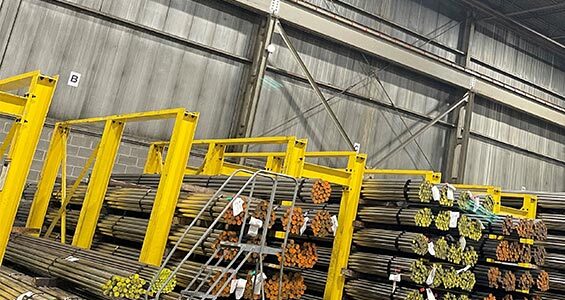
How to Select the Right Steel Grade
Be careful when selecting a steel grade because you risk either paying a premium for properties the application doesn’t need or buying steel that may fail prematurely.
With thousands of steel grades available, each with widely different properties, it’s difficult to know which will perform best in any given application. This article discusses how to select steel and the main factors to consider.
Factors to Consider
Mechanical Properties
Strength
Steel strength is defined by yield strength, ultimate tensile strength (UTS), and fatigue strength.
Yield strength is the load at which steel takes on a permanent deformation and won’t return to its original size.
UTS is the load at which the steel breaks and is greater than the yield strength.
Fatigue strength is the load at which a steel will fail after a defined number of cycles. It’s sometimes defined as a proportion of the UTS for a specific type or grade.
Carbon content affects strength. In general, higher carbon steel is stronger, but other alloying elements have an influence, too. Alloy steels known for their strength are:
- 1085: High carbon, plus a proportion of manganese. UTS is around 100,000 PSI.
- 4140L Chromium-molybdenum steel with a UTS of 95,000 PSI.
- 4340: A nickel-chromium alloy steel with a UTS of 130,000 PSI.
Toughness
Toughness refers to a material’s ability to absorb impacts without fracturing. It’s the opposite of brittleness; steel can be both hard and strong, yet if it’s brittle rather than tough, it may shatter when struck.
Toughness is measured by the Charpy impact test, in which a standard coupon is struck and fractured by a pendulum. The energy absorbed by the coupon, in Joules (J), is the toughness of the material.
Toughness is especially important in applications like automotive suspensions and defense vehicles where impacts are likely.
High-carbon steels are strong but usually lack toughness. Manganese, nickel, chromium, and molybdenum increase toughness by raising ductility without reducing strength. Toughness can also be modified through heat treatment processes like quenching and tempering.
Three grades of steel known for their toughness are:
- 4140: Chromium-molybdenum steel with a toughness of 30 to 50 J.
- 4340: Nickel-chromium steel with a toughness of 50 to 100 J.
- 8620: Chromium-nickel-molybdenum-manganese steel with a toughness of 60 to 100 J.
Hardness
Hardness is measured by pressing a probe against the surface with a set force. The size of the indentation is inversely proportional to hardness. Steel hardness is often reported in terms of the Rockwell C hardness scale (HRC).
Raising carbon content creates harder steel, although chromium, vanadium, tungsten, and molybdenum also help. Hardness can also be changed by quenching and tempering (tempering being needed to reduce brittleness).
Three particularly hard steels include:
- 1095: A plain carbon steel (HRC 66).
- 4340: Nickel-chromium alloy steel (HRC 58 to 63).
- 8620: An alloy steel (HRC 60 to 65).
Operating Environment
Corrosion Resistance
Iron’s tendency to bond with oxygen causes corrosion and rusting. This tendency can be slowed by alloying it with elements like chromium and nickel.
Stainless steels, which contain at least 10.5% chromium, are naturally corrosion-resistant, but many other alloy steels have moderate-to-good corrosion resistance, too. Widely used corrosion-resistant steels include:
- SAE 304: Stainless steel used for food processing equipment.
- SAE 316: Stainless with excellent resistance to saltwater corrosion.
- 4140: A hard and tough chromium-molybdenum steel.
- 4340: A hard and tough nickel-chromium alloy steel.
- 8620: Chromium-nickel-molybdenum-manganese alloy steel.
Temperature Resistance
Although most grades of steel have a high melting point, their strength declines quickly above 750 degrees Fahrenheit, and most also suffer accelerated corrosion at temperatures above 550 degrees Fahrenheit.
Higher carbon content and alloy steels have higher practical working temperature limits. Adding chromium, nickel, molybdenum, vanadium, and tungsten increases temperature resistance. Austenitic stainless steels also perform exceptionally well at elevated temperatures.
Steels to consider for high-temperature applications include:
- 6150: chromium-vanadium alloy that withstands up to 1,000 degrees Fahrenheit.
- 4140: Goes up to 1,100 degrees Fahrenheit.
- 4340: Goes up to 1,100 degrees Fahrenheit.
- SAE 310: An austenitic stainless steel that tolerates up to 2,100 degrees Fahrenheit.
Manufacturing Method
Steel will inevitably undergo shaping or material removal operations (cold heading, milling, drilling, etc.). So, the ease or difficulty of producing the final form should be part of the grade selection process, too.
Low-carbon steels have good machinability, and their ductility permits forming operations like forging. As carbon content rises, increased toughness makes processing more difficult. Tempering and normalizing heat treatment processes improve machinability by reducing hardness.
Generally, steels with alloying elements are difficult to machine, and some don’t weld well. Austenitic stainless steels are an exception, as they have good weldability.
Widely used grades with moderate-to-good machinability include:
- 1212: A mild steel that’s often considered the benchmark for machinability.
- 1215: A free-machining mild steel with better machinability than 1212.
- SAE 303: A stainless steel with machinability only slightly inferior to 1212.
Notably, despite its high strength, toughness, and hardness, the machinability of 4140 is significantly worse than that of 1212 or 303.
Speak With an Expert
Rather than risk a mistake, the safest approach when selecting steel is to work with an experienced steel supplier like King Steel.
Founded over 50 years ago, King Steel is a trusted supplier of hot-rolled and cold-drawn steel bar, wire, and rod products. We also offer a wide range of processing capabilities, including heat treatment, turning/polishing, machining, descaling, shot blasting, and eddy current testing, to ensure we provide the exact specification and finish you need.
Contact us today with your application requirements, and one of our experts will assist you.
